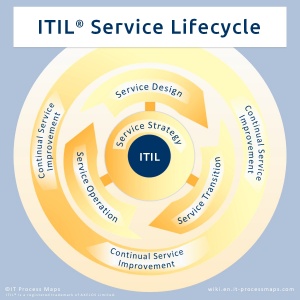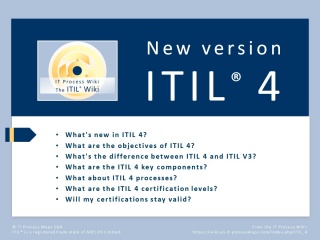History of ITIL: Difference between revisions
No edit summary |
No edit summary |
||
| Line 69: | Line 69: | ||
* IT Process Model (IBM) | * IT Process Model (IBM) | ||
* Microsoft Operations Framework | * Microsoft Operations Framework | ||
* ... and the streamlined [https://yasm.com/wiki/en/index.php/Main_Page YaSM service management model] | |||
<p> </p> | <p> </p> | ||
| Line 99: | Line 100: | ||
As the official ITIL Update FAQs state, "ITIL 2011 is an update, not a new version". No entirely new concepts have been added, but the aim of the update is to "resolve errors and inconsistencies in the text and diagrams across the whole suite". As for ITIL examinations, no re-certifications are required, but updated syllabuses and examinations will be used to bring the certification scheme into line with the latest guidance. | As the official ITIL Update FAQs state, "ITIL 2011 is an update, not a new version". No entirely new concepts have been added, but the aim of the update is to "resolve errors and inconsistencies in the text and diagrams across the whole suite". As for ITIL examinations, no re-certifications are required, but updated syllabuses and examinations will be used to bring the certification scheme into line with the latest guidance. | ||
There also seems to be a new naming convention. As "ITIL V3 (2011 Edition)" is somewhat unwieldy, and ITIL V2 will not be around for much longer, the latest edition is now referred to as | There also seems to be a new naming convention. As "ITIL V3 (2011 Edition)" is somewhat unwieldy, and ITIL V2 will not be around for much longer, the latest edition is now referred to as "ITIL 2011" or simply "ITIL", while the term "ITIL 2007" is used for the first edition of ITIL V3. | ||
We updated this ITIL Wiki and aligned it with the recent edition of ITIL 2011 when upgrading our ITIL process model (the [https://en.it-processmaps.com/products/itil-process-map.html ITIL Process Map]). | We updated this ITIL Wiki and aligned it with the recent edition of ITIL 2011 when upgrading our ITIL process model (the [https://en.it-processmaps.com/products/itil-process-map.html ITIL Process Map]). | ||
There is also a special page in this Wiki where you can find a summary of [[ITIL 2011| | There is also a special page in this Wiki where you can find a summary of the [[ITIL 2011|main differences between ITIL 2007 and ITIL 2011]]. | ||
<p> </p> | |||
==ITIL 4== | |||
[[Image:Itil-4.jpg|thumb|320px|right|none|alt=What is new in ITIL 4, scheduled for release in Q1/2019? FAQs: The new ITIL edition 4.|link=https://wiki.en.it-processmaps.com/index.php/File:Itil-4.jpg|[[ITIL 4|The latest edition of ITIL® 4]]]] | |||
The next release of ITIL ('[[ITIL 4]]') is expected to launch in the first quarter of 2019. | |||
It's the first major update to the ITIL framework since 2011, designed in large part to keep up with recent trends in software development and IT operations. | |||
Learn more about the new ITIL version: | |||
→ [[ITIL_4#Objectcives|What are the objectives of ITIL 4?]] | |||
→ [[ITIL_4#What.27s_new_in_ITIL_4.3F|What's new in ITIL 4?]] | |||
→ [[ITIL_4#ITIL_4_and_ITIL_V3:_What.27s_the_difference.3F|What's the difference between ITIL 4 and ITIL V3?]] | |||
<br style="clear:both;"/> | |||
<p> </p> | <p> </p> | ||
| Line 113: | Line 133: | ||
[2] John S Stewart. "[http://internationalbestpracticeinstitute.wordpress.com/2013/02/11/how-itil-started/ How ITIL started]". -- Blog IBPI (The International Best Practice Institute) www.ibpi.org, February 11, 2013. Retrieved February 27, 2013. | [2] John S Stewart. "[http://internationalbestpracticeinstitute.wordpress.com/2013/02/11/how-itil-started/ How ITIL started]". -- Blog IBPI (The International Best Practice Institute) www.ibpi.org, February 11, 2013. Retrieved February 27, 2013. | ||
<html>By:  Andrea Kempter <a rel="author" href="https:// | <html>By:  Andrea Kempter <a rel="author" href="https://www.linkedin.com/in/andreakempter"><img style="margin:0px 0px 0px 0px;" src="/images/bookmarking/linkedin.png" width="16" height="16" title="By: Andrea Kempter | Profile on LinkedIn" alt="Author: Andrea Kempter, IT Process Maps GbR" /></a>, IT Process Maps.</p> | ||
<p> </p> | <p> </p> | ||
| Line 138: | Line 158: | ||
<a itemprop="item" href="https://wiki.en.it-processmaps.com/index.php/History_of_ITIL#ITIL_2011_Upgrade"> | <a itemprop="item" href="https://wiki.en.it-processmaps.com/index.php/History_of_ITIL#ITIL_2011_Upgrade"> | ||
<span itemprop="name">ITIL 2011 Upgrade</span></a> | <span itemprop="name">ITIL 2011 Upgrade</span></a> | ||
<meta itemprop="position" content="5" /></span> | <meta itemprop="position" content="5" /></span> › | ||
<span itemprop="itemListElement" itemscope itemtype="http://schema.org/ListItem"> | |||
<a itemprop="item" href="https://wiki.en.it-processmaps.com/index.php/History_of_ITIL#ITIL_4"> | |||
<span itemprop="name">ITIL 4</span></a> | |||
<meta itemprop="position" content="6" /></span> | |||
</span> | </span> | ||
</small></p> | </small></p> | ||
| Line 172: | Line 196: | ||
<link itemprop="citation" href="https://wiki.de.it-processmaps.com/index.php/Geschichte_von_ITIL" /> | <link itemprop="citation" href="https://wiki.de.it-processmaps.com/index.php/Geschichte_von_ITIL" /> | ||
<link itemprop="citation" href="https://wiki.es.it-processmaps.com/index.php/Historia_de_ITIL" /> | <link itemprop="citation" href="https://wiki.es.it-processmaps.com/index.php/Historia_de_ITIL" /> | ||
<link itemprop="author" href="https:// | <link itemprop="author" href="https://www.linkedin.com/in/andreakempter" /> | ||
<meta itemprop="author" content="Andrea Kempter" /> | <meta itemprop="author" content="Andrea Kempter" /> | ||
<meta itemprop="creator copyrightHolder publisher" content="IT Process Maps" /> | <meta itemprop="creator copyrightHolder publisher" content="IT Process Maps" /> | ||
Revision as of 14:24, 18 February 2019


What is ITIL?
The objective of the IT Infrastructure Library was to develop effective and efficient methods for the provision of IT services - in other words a catalogue of best practices for the IT organization, which today is known as ITIL®.
How did ITIL start?
The IT Infrastructure Library ITIL® [1] was developed at the end of the 1980's by the Central Computing and Telecommunications Agency (CCTA), a government agency in Great Britain. The reason for commissioning the CCTA was a lack of quality of the IT services procured by the British Government, so that a method had to be found to achieve better quality and simultaneously decrease their costs.
IT Service Management Best Practices
The essence of the methods is to make IT services explicit and strictly focused on client needs. This is combined with clearly defined responsibilities for service provision within the IT organization, and effectively designed IT processes. As a result, the IT organization concentrates on the services required by the customer side, rather than being focused on technologies.
The recommendations thus compiled are very broadly valid. It was found that the requirements of the businesses and organizations examined by the CCTA were mostly similar, independent of their size or industry sector.
A series of books on ITIL has been issued since 1989 by the Office of Government Commerce (OGC), an administrative body of the Government of Great Britain. Today, ITIL is a registered trademark of Axelos Limited.
Recognition of ITIL as a De-facto Standard
In the past years, ITIL has become the de-facto standard for IT service management (ITSM). Increasingly, IT managers developed an awareness for the service- and customer-driven approach championed by ITIL, and the ITIL terminology is widely understood and used.
The ideas behind ITIL have found their way into a number of other frameworks and standards for IT service management, as for example:
- ISO 20000 (formerly BS 15000): Information Technology - Service Management
- HP ITSM Reference Model (Hewlett Packard)
- IT Process Model (IBM)
- Microsoft Operations Framework
- ... and the streamlined YaSM service management model
The ITIL Service Lifecycle
In 2007 the OGC published a completely revised version of ITIL, known as "ITIL Version 3 (ITIL V3)".
ITIL V3 reflects the experiences gained with the earlier versions and puts a greater emphasis on creating business value.

In comparison to ITIL V2 - which consisted of nine books - ITIL V3 is more streamlined around a set of five new core publications which together form the "ITIL Service Lifecycle":
The rationale for organizing the ITIL books in this way was to establish a Deming-like Plan-Do-Check-Act cycle focused on continual improvement.
Overall, ITIL V3 complements the processes known from ITIL V2 with a number of new processes and puts more emphasis on producing value for the business. The underlying principles of ITIL are largely unchanged.
ITIL 2011 Upgrade
Four years after the introduction of ITIL V3 the main guidance has been updated, taking into account feedback from the user and training community: the current ITIL 2011 edition.
As the official ITIL Update FAQs state, "ITIL 2011 is an update, not a new version". No entirely new concepts have been added, but the aim of the update is to "resolve errors and inconsistencies in the text and diagrams across the whole suite". As for ITIL examinations, no re-certifications are required, but updated syllabuses and examinations will be used to bring the certification scheme into line with the latest guidance.
There also seems to be a new naming convention. As "ITIL V3 (2011 Edition)" is somewhat unwieldy, and ITIL V2 will not be around for much longer, the latest edition is now referred to as "ITIL 2011" or simply "ITIL", while the term "ITIL 2007" is used for the first edition of ITIL V3.
We updated this ITIL Wiki and aligned it with the recent edition of ITIL 2011 when upgrading our ITIL process model (the ITIL Process Map).
There is also a special page in this Wiki where you can find a summary of the main differences between ITIL 2007 and ITIL 2011.
ITIL 4

The next release of ITIL ('ITIL 4') is expected to launch in the first quarter of 2019.
It's the first major update to the ITIL framework since 2011, designed in large part to keep up with recent trends in software development and IT operations.
Learn more about the new ITIL version:
→ What are the objectives of ITIL 4?
→ What's the difference between ITIL 4 and ITIL V3?
Links and additional information
[1] IT Infrastructure Library® and ITIL® are registered trade marks of AXELOS Limited.
[2] John S Stewart. "How ITIL started". -- Blog IBPI (The International Best Practice Institute) www.ibpi.org, February 11, 2013. Retrieved February 27, 2013.
By: Andrea Kempter ![]() , IT Process Maps.
, IT Process Maps.
What is ITIL? › ITSM Best Practices › De-facto Standard ITIL › ITIL Service Lifecycle › ITIL 2011 Upgrade › ITIL 4






